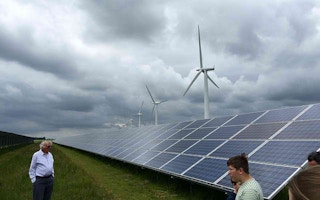What’s keeping solar and wind power from fully taking over the electric grid? For starters, the sun only shines during the day. Wind blows intermittently, is seasonally variable, and is not always blowing when the energy is needed. But what if solar and wind work together?
“Wind resource tends to complement solar resource,” says Sarah Kurtz of the U.S. Department of Energy’s National Renewable Energy Laboratory. “Here in Colorado, for instance, the windiest time is during the winter and spring months. In winter, we don’t have as much sunshine, but we tend to get more wind and stronger wind.”
A handful of enterprising renewable energy developers are now exploring how solar and wind might better work together, developing hybrid solar–wind projects to take advantage of the power-generating strengths of each — with the two technologies in tandem serving as a better replacement for climate-warming fossil fuels than either could be alone.
Tacking on solar
On the rolling plains just west of Australia’s Great Dividing Range, construction is expected to begin on a 10-megawatt solar farm adjacent to 73 wind turbines that are already online.
“
If you’re in a location where the wind does blow, and especially where the wind complements solar, until the batteries get cheaper than the wind power itself, you’re going to be better off adding wind [than batteries].
Sarah Kurtz, U.S. Department of Energy’s National Renewable Energy Laboratory
According to the Australian Renewable Energy Agency — ARENA, a governmental agency tasked with increasing deployment of renewable energy — which has invested A$9.9 million in the project a couple hours’ drive southwest of Sydney, the co-location of solar and wind provides more continuous energy generation than having either technology working alone.
But that’s not the only benefit. Co-locating wind and solar plants can save money on grid connections, site development and approvals, says ARENA CEO Ivor Frischknecht. By building the Gullen Solar Farm adjacent to the existing wind project, Frischknecht estimates savings as high as A$6 million — reducing the cost of the project by a full 20 per cent.
Frischknecht hopes that the Gullen Range project will serve as a model for how tacking solar onto existing wind farms can boost its application. “Scale isn’t as important for competitiveness when plants are co-located, meaning the approach could also unlock new markets for medium-scale solar PV projects,” he says.
And just how big could these new markets be? Frischknecht points to an ARENA-funded study that found an estimated 1,000 MW of solar generating potential at existing wind farms in Australia— enough, ARENA calculates, to power 700,000 homes.
“The lessons learned at Gullen Range will be invaluable, as this is the first project of its type in Australia,” Frischknecht says. “It has the potential to cement industry confidence in the approach and provide a blueprint for similar projects to follow.”
Battery boosters
Expanding power production and saving money on installation aren’t the only benefits that can come from combining wind and solar. When applied to microgrid systems — local energy grids that can disconnect from the traditional grid and operate autonomously — combined solar and wind can help cut battery costs as well, says NREL’s Kurtz.
According to Kurtz, microgrids are finding application in places like Hawaii and India where utility prices are exorbitantly high or where communities are too remote to be tied into the macrogrid.
Microgrids powered by photovoltaics require battery storage, since people need power when the sun isn’t shining. The problem is, batteries are still quite expensive. Adding wind can help cut the battery costs, since the wind can (and often does) blow when the sun doesn’t shine.
“If you’re in a location where the wind does blow, and especially where the wind complements solar, until the batteries get cheaper than the wind power itself, you’re going to be better off adding wind [than batteries],” Kurtz says.
The microgrid will still need some form of storage, “because there will always be a night when the wind isn’t blowing,” she adds. But the solar and wind combination “can make battery demand much smaller.”
This story was published with permission from Ensia.com. Read the full story.










